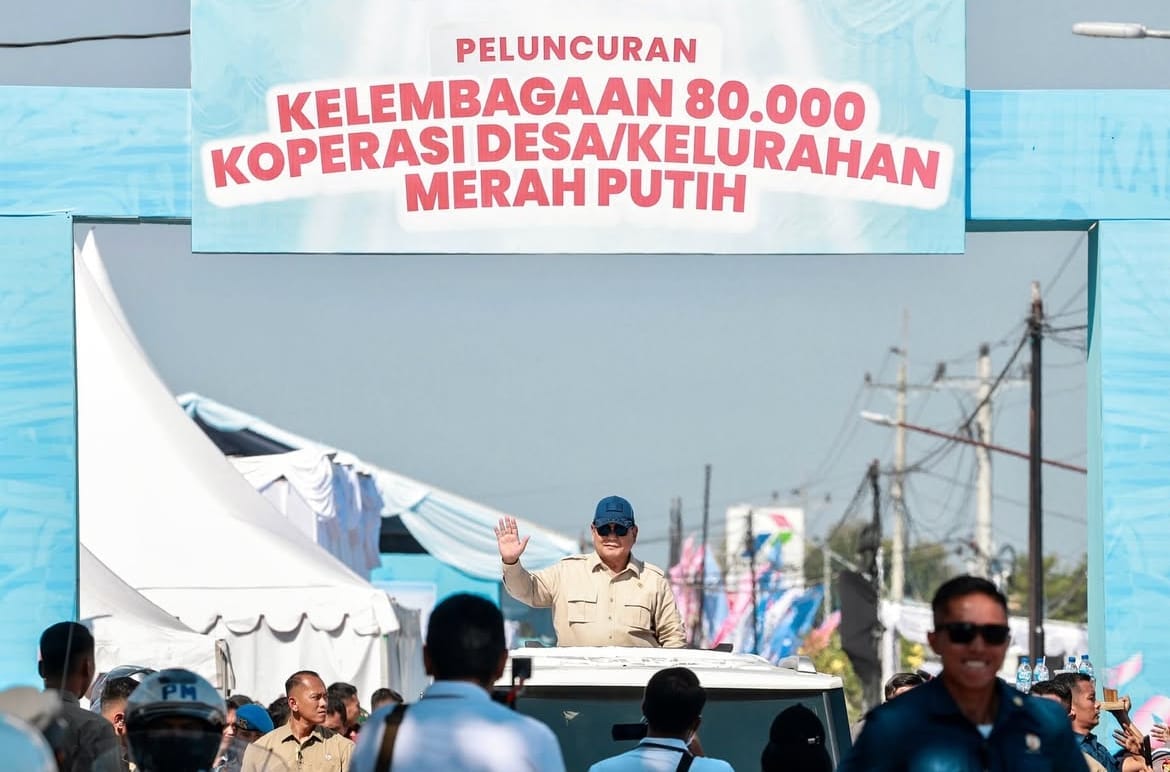The logistics industry has the opportunity to take part in the government's megaproject to develop more than 80,000 units of the Merah-Putih Village Cooperative (KDMP). This sector is one of the spearheads of the distribution of agricultural products and various basic necessities.
As an illustration, in the Speech on the Financial Note of the State Revenue and Expenditure Budget (APBN) 2026 before the People's Consultative Assembly (MPR), last week, President Prabowo Subianto reaffirmed his commitment to ensuring that KDMP functions optimally.
"The establishment of the Merah Putih Village and Sub-District Cooperative has started this year. By the end of 2025, each cooperative will have a warehouse, will have cold storage, will have outlets, and each cooperative will have two truck vehicles to pick up and deliver their agricultural products," said Prabowo, Friday (15/8/2025).
The addition of distribution facilities and capacity is well-founded. According to the President, the completeness of these facilities supports the government's mission to improve public nutrition and increase the consumption of animal protein - especially fish.

Not only that, the addition of KDMP's distribution capacity as an engine of the village economy is also expected to accelerate the transportation of village products to reach the market.
On various occasions, both the Minister of Cooperatives Budi Arie Setiadi and the Deputy Minister of Cooperatives Ferry Juliantono have said that the KDMP is planned to become a distribution chain for production outputs to community needs such as agricultural products to medicines. Therefore, a strong logistics system is needed to support the success of this program.
The President's commitment received a positive response from logistics and national supply chain business actors. Chairman of the Indonesian Logistics Forwarders Association (ALFI) Institute Yukki Nugrahawan Hanafi stated that the integration of the logistics sector can encourage economic equality, job creation, and the activity of the national supply chain logistics sector.
“We see an opportunity for collaboration in the national logistics sector to help realize this vision. However, we believe the government needs to consider four important factors to ensure optimal realization,” Yukki explained in a written statement received by SUAR on Friday (16/8/2025).
The four important factors Yukki referred to include: the organizational governance capacity of KMP in running optimal logistics and supply chains, the availability of an efficient fleet, the digitalization of logistics and supply chains, and ensuring the availability of logistics and supply chain human resources.
“In this context, logistics and supply chain business actors are ready to work together to provide assistance, training, and business collaboration to make this vision a success,” Yukki concluded.
Beware of failure gaps
However, cooperative researcher and Chairman of the Association of Strategic Socio-Economic Cadres (AKSES), Suroto, warned of KDMP failure gaps in the implementation of large plans such as President Prabowo's idea. The crucial point lies in the mechanism for transferring non-performing loan risk, which directly cuts Village Funds, and guaranteeing commodities sold by KDMP to Himbara banks (state-owned banks).
“If the market does not absorb these goods, the losses will not fall on the bank or the supplier. Village Funds, which should be for development and community empowerment, will be cut to cover these losses. The village only becomes an extension of execution, without the power to determine suppliers, types of goods, or business models,” Suroto wrote in a written statement received by SUAR on Friday (15/08).
At first glance, this mechanism makes villages vulnerable to being trapped in a prolonged debt cycle and losing their direction of autonomous development. On the other hand, this mechanism actually triggers villages to strategize so that KDMP finances are maintained. In addition, its productivity grows optimally and village products can compete competitively.
Partnerships must be by design
To ensure the optimal functioning of KDMP, logistics entrepreneurs emphasize that the implementation of this plan should not only pay attention to the readiness of the macroscopic plan, but also to the technical aspects in the field.
The Chairman of the Indonesian Logistics Association, Mahendra Rianto, underlined that the challenge lies in the details, which are often overlooked in plans that are too large and massive. In fact, aspects in the field are more decisive for the success or failure of the implementation of government plans. Therefore, the implementation of this logistics plan should not be carried out in a hurry.
He gave the example of the government's plan to prepare cold storage in each KDMP unit, but did not explain the implementation of the cold supply chain flow as a framework.
Mahendra explained that each commodity has a different cold supply chain flow and treatment. For example, fish from Sulawesi and Maluku. "Can our government convince markets in Singapore, Malaysia, Hong Kong, China, or Australia to buy our fish? The shelf life of fish as perishable food is not long. Bacteria levels must be monitored strictly, especially in countries that apply high standards. Have we done that yet?" he said.
The biggest challenge in the cold supply chain, according to Mahendra, is the degree of difference in the quality of freshness of goods at harvest and those received by buyers in the market. Transportation needs, therefore, must be part of a comprehensive integrated plan.
“Cold storage does not solve the problem. What solves the problem is the movement of goods to the market to be sold. If it is only stored in cold storage and not sold, the goods will eventually spoil,” Mahendra said when contacted by SUAR, (16/08).
“Cold storage does not solve the problem. What solves the problem is the movement of goods to the market to be sold,” said Mahendra.
Mahendra reminded that cold storage procurement steps were also carried out several years ago, with results that were far from expectations. “Now, the cold storage is just sitting there, empty. Don't repeat the same mistake, because of unclear information, pouring funds into something that was wrong from the start,” he said.
There is an effective strategy that the government can take to prevent repeated errors in the implementation of the distribution capacity improvement plan. Namely, partnering with private partnerships to provide training and upgrading of human resources and the establishment of quality control that makes KDMP products competitive in the market.
“Try having the supermarket chains that get operating permits teach the cooperatives and take goods from them. Don't reverse it. The government can say, 'Please take these goods from the village community. Tell them how to meet the standard quality.' So they [the supermarket chains] guide them,” Mahendra said.
In addition, KDMP can only succeed if the government, farmers/fishermen, and the market have a mutual understanding. “The fact is, our farmers need money every day. The government must understand this if it wants to fix the supply chain. Don't let farmers end up in debt after the harvest, while the middlemen are the ones who profit. The government must be honest and open about this issue,” he said.
Writers: Benediktus Krisna Yogatama and Christian Wibisana




